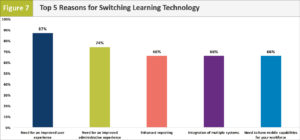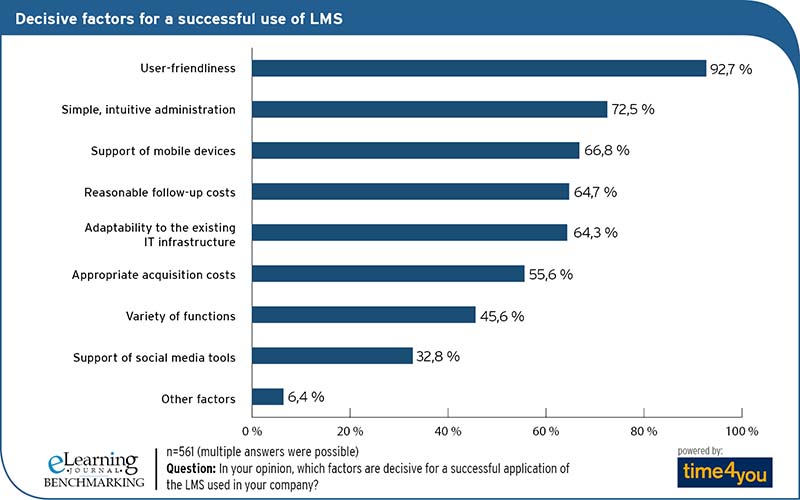Learning Management Systems (LMS) are a helpful tool for the provision and distribution of eLearning content and usually contain numerous other features, such as education controlling. This makes it easier for many companies to organize their internal learning process. When it comes to getting started with eLearning, an LMS is usually the first thing a company invests in. For this reason, the software is already in use almost all over Germany, Austria and Switzerland. But their potential is far from exhausted.

LMS is the most important eLearning infrastructure in most German-speaking companies as central software for the administration and provision of in-company training. This is also shown by the results of this year’s eLearning BENCHMARKING study, in which 72.8 % of the participating companies in the DACH area stated that they were already working with such a system. Another 14% of the study participants are currently planning to purchase an LMS. Only around 11 % are currently not considering an implementation. According to 88.8% of the companies surveyed, the systems are particularly popular for providing learning content, such as web-based training, event management (67.7%) and education controlling (64.9%). This underlines the relevance the system already has for the digital continuing education market. However, despite frequently falling negative forecasts due to a lack of flexibility, there are still no limits for LMS. As the BENCHMARKING study also shows, some of them still have great potential for improvement.
Within the study, more than half of the companies stated that they were dissatisfied with their current use of LMS – whether due to shortcomings or the potential for improvement, especially with regard to user- friendliness. A retrospective change is often not easy and costly, which is why only 8.2% of the companies concerned are considering this. But where does this dissatisfaction come from?
The biggest shortcoming is the user-friendliness
Particularly frequently mentioned in this regard was the lack of user-friendliness, which seems to be the hallmark of most LMS and has been attributed to the systems since they entered the market. However, this is of particular relevance in terms of employee acceptance for the topic of eLearning. Only if an LMS is intuitive and uncomplicated to use, it is also popular with learners. But also in terms of appearance and layout, the systems often leave much to be desired. For example, the adaptation to the company design would be desirable here. And also for the use in a Social Learning format, many LMS are less suitable so far. These results are also underlined by the Brandon Hall Group’s Global Learning Technology Study 2016, according to which as many as 44% of the companies surveyed worldwide that already have an LMS are considering switching. With 87%, the most common reason for this is the potential for improvement in user-friendliness for learners, closely followed by the desire for improved administrative usability (74%), better reporting options (66%) and suitability on mobile devices (66%).

In order to avoid this dissatisfaction from the outset, it is advisable to thoroughly explore the market and find out what individual demands the company has on such an infrastructure before deciding to purchase an LMS. Although the LMS of different providers usually cover the same basic functions, they often differ with regard to other topics, such as user-friendliness, design, extended functions and integration options. A catalogue of requirements can help you find your way around here. However, so far only half of the companies currently using an LMS have produced such a catalogue. Especially in a company where eLearning is still in its infancy, it is often difficult to define in advance what the company needs for successful use, since eLearning itself has often not yet been specifically planned. 55.6% of the companies made their decision in favour of an LMS provider primarily on the basis of compliance with their catalogue of requirements, but what if they are still unclear about this? In the foreground are the price-performance ratio and the user-friendliness for the learners as decisive decision factors. But simple, intuitive administration and support for mobile devices are also required. In addition, 33.3% of the companies attach importance to being understood by their suppliers in their needs. If these factors are right – and companies agree with a large majority – the use of an LMS can be crowned with success.
What is the future of the LMS market?
In this respect, the mmb institute asked experts on the eLearning market about the future prospects of Learning Management Systems and received positive feedback from 81% of all votes. Although the systems certainly have room for improvement in terms of user centricity and flexibility, they also have great development potential – whether through the integration of adaptive learning systems or performance support. If the LMS market adheres to these potentials and continues to meet the requirements in the future, the systems will continue to play a substantial role in continuing vocational training.





